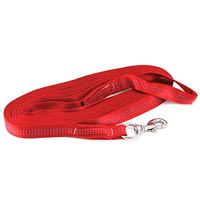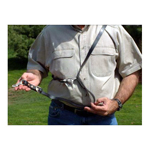May 17, 2011
My K-9 partner works very well with an electric collar, the problem is the dog will drag me down the street when I put a leash on him. What can I do?
Full Question:
Mr. Frawley,Let me start by saying "Great job" on the police tactical deployment and muzzle fighting videos. These were both great, and helped our unit a lot.
I am a police K9 handler and trainer in Fl. I am a big fan of your site and your videos. I have been involved in police K9 for 6 years, and have prior Schutzhund experience. I have been handling a very tough german shepherd for the last three years. He has very high drives and is very hard. He was almost washed out of patrol school because the trainers at the time though he would be too uncontrollable and un-trainable (one of those dogs that would break choke chains and not even flinch under a level 10 prong collar correction).
Anyway, with a lot of effort and the use of a remote training collar (using the low level, continuous stimulation "escape" method) The dog was brought to understand what we wanted of him, and has become one of the most controlled easy to work patrol dogs. The dog is very obedient, OFF LEAD, but when he gets hooked on lead, he tries to forge when heeling and pulls all over the place. He doesn't respond to collar corrections, so I end up flailing around for the e-collar transmitter as he pulls. If I unsnap the lead, he hits the brakes and goes back into a perfect heel.
I would just keep him off lead all of the time, but due to, ummmm... "political" reasons, I have to hook him up sometimes. Any suggestions?
I really appreciate your time, sorry about the lengthy letter, but I wanted you to be able to understand the whole situation.
Thanks!!!
- Ofc. Brian
Cocoa, FL

 Ed's Answer:
Ed's Answer:
This sounds like one of those dogs that are never out without a collar on. I am no longer a fan of the “ESCAPE METHOD” of e-collar work. In its time this was an acceptable way to train certain dogs certain things – but not police dogs. I think the dog must know where the shock comes from – which is the handler This means the dog is never given a shock until just after the handler tells him NO. When the dog learns that the shock comes from the handler then he looks to the handler as a god – someone who has complete control over him at all times.
This applies to protection work and obedience work. In your case it would and should be used with the dog on a prong collar. When told to heel the dog is commanded to HEEL (in a normal voice) 3 hard quick jerks with the prong collar and then stimulation from the collar (not the highest level – you will have to experiment to find the right level that does not shut the dog down).
When using a leash correction there are two ways to use it:
This applies to protection work and obedience work. In your case it would and should be used with the dog on a prong collar. When told to heel the dog is commanded to HEEL (in a normal voice) 3 hard quick jerks with the prong collar and then stimulation from the collar (not the highest level – you will have to experiment to find the right level that does not shut the dog down).
When using a leash correction there are two ways to use it:
- Three hard quick jerks – which builds drive and turns on the dogs nerves to make him react – in heeling this makes him look to you and pay attention.
- One hard jerk which takes drive out of the dog and makes him compliant. The one jerk method is used in the DOWN, SIT, and OUT and be silent.
100% (5 out of 5)
respondents found this answer helpful


Can't find what you're looking for?






